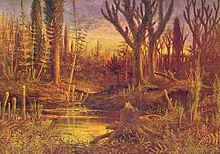Devonium

Devonium[1] est systema stratigraphicum et periodus geologica.
Divisio quarta ab infima constituit tam aerae Palaeozoicae quam aeonis Phanerozoicae. Abhinc 4 192 ± 32 centies milium annorum coepit, antecessore Silurio. Finem habuit abhinc 3 589 ± 4 centies milium annorum, successore Carbonifero, secundum scalam aevorum geologicorum Commissionis Internationalis Stratigraphicae.[2] Devonium inceptum ex antiquissimis fossilibus Monograpti uniformis datur.[3]

In tres series dividitur, quae inferius, medium, superius appellantur. In septem stadia dividitur, quae ab infimo ad supremum Lochkovium, Pragium, Emsium, Eifelium, Givetium, Frasnium, Famennium appellantur.[4]
E nomine Devoniae appellatur, regione Angliae occidentalis, ubi strata huius periodi primum recognita sunt. Primum anno 1840 Adam Sedgwick et Rodericus Murchison nomen Anglicum Devonian system definiverunt e propositione Gulielmi Lonsdale. [5][6][7]
Notae
[recensere | fontem recensere]- ↑ Christof Kuhn, "Etymology of Geological Time Units"
- ↑ "International Chronostratigraphic Chart"
- ↑ Ita de:wiki
- ↑ "Internationale Chronostratigraphische Tabelle" (2017)
- ↑ "Mr. Austen's communication [was] read December 1837 ... It was immediately after the reading of that paper...that I formed the opinion relative to the limestones of Devonshire being of the age of the old red sandstone; and which I afterwards suggested first to Mr. Murchison and then to Prof. Sedgwick" (p. 724): William Lonsdale, "Notes on the age of limestones from south Devonshire" in Transactions of the Geological Society of London 2a ser. vol. 5 (1840) (pp. 721–738 apud Google Books)
- ↑ "Again, Mr. Lonsdale, after an extensive examination of the fossils of South Devon, had pronounced them, more than a year since, to form a group intermediate between those of the Carboniferous and Silurian systems" (p. 690); "We propose therefore, for the future, to designate these groups collectively by the name Devonian system" (p. 701): Adam Sedgwick, R. I. Murchison, "On the physical structure of Devonshire, and on the subdivisions and geological relations of its older stratified deposits" in Transactions of the Geological Society of London 2a ser. vol. 5 (1840) (pp. 633–705 apud Google Books)
- ↑ De historia nominis definitionisque vide: Mary Grace Wilmarth, The Geologic Time Classification of the United States Geological Survey Compared With Other Classifications, accompanied by the original definitions of era, period and epoch terms (United States Geological Survey Bulletin no. 769. Vasingtoniae: U.S. Government Printing Office, 1925) (Textus apud Google Books)
Bibliographia
[recensere | fontem recensere]- R. A. Livermore, A. G. Smith, J. C. Briden, "Palaeomagnetic Constraints on the Distribution of Continents in the Late Silurian and Early Devonian" in Philosophical Transactions of the Royal Society of London. Series B, Biological Sciences vol. 309 no. 1138 (Evolution and Environment in the Late Silurian and Early Devonian. 2 Aprilis 1985) pp. 29-56
Nexus externi
[recensere | fontem recensere]| Vicimedia Communia plura habent quae ad Devonium spectant. |
- Exampla reliquorum aevi Devoniani (Germanice)
- "Devonian" olim apud Palaeos divulgatum
|
Siderium • Rhyacium • Orosirium • Statherium • Calymmium • Ectasium • Stenium • Tonium • Cryogenium • Ediacarium • Cambrium • Ordovicium • Silurium • Devonium • Carboniferum • Permium • Triassicum • Iurassicum • Cretaceum • Palaeogenicum • Neogenicum • Quaternarium Capsae cognatae: Aeones • Aerae • Periodi • Epochae • Aetates geologicae = Aeonothemata • Aerathemata • Systemata • Series • Stadia stratigraphica | |

